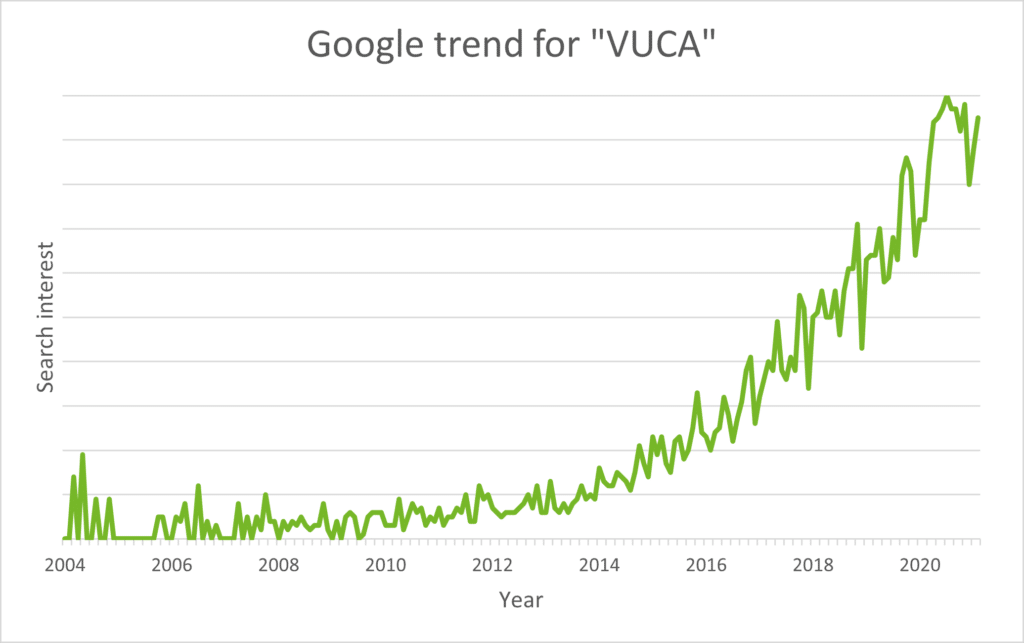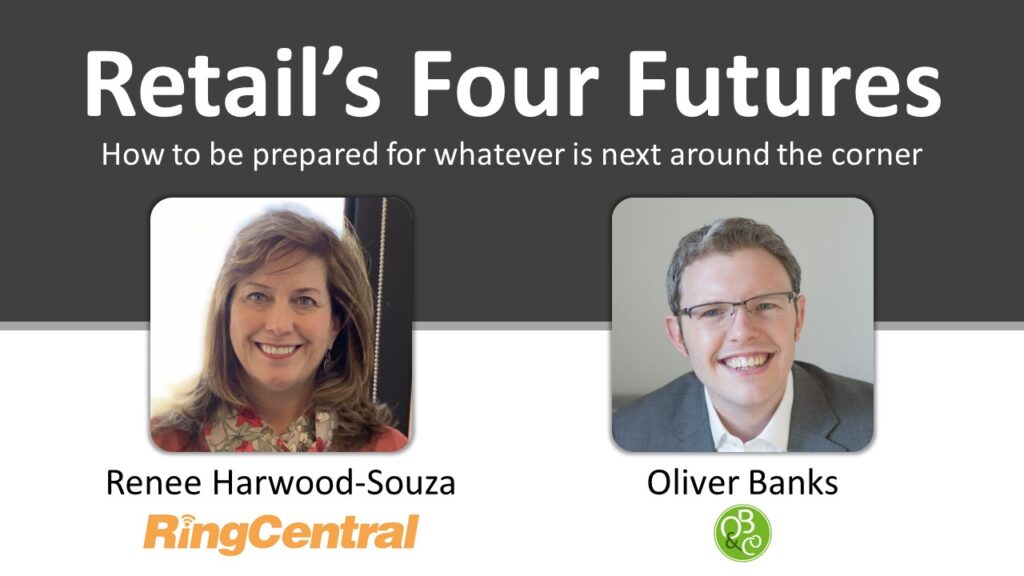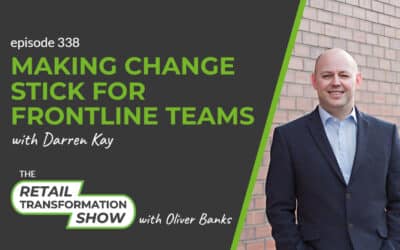VUCA is a concept that originated from the US military to describe the state of the world following the Cold War. It stands for volatile, uncertain, complex and ambiguous.
Over the past year, many have used this acronym to explain what’s going on (I know I’m guilty of this too!). But VUCA is not a new trend. Back in 2014, the Harvard Business Review called it a “trendy managerial acronym.” And when you look at the search interest over the past 17 years, you can see the exponentially growing interest in VUCA.

This trend suggests that we, as a global population, feel that we live in an increasingly unpredictable world. It isn’t a pandemic induced feeling. It has been coming for some time.
But 2020 has brought it towards a point of action. We’ve all heard, witnessed and experienced the stories of acceleration and flexibility.
The media report on what seems to be an increasing volume of national or international crises occurring, be it the climate crisis, or Brexit, or wildfires, political crises and many more. But with these large scale crises, you could be forgiven for feeling that the world continues to fall apart and there seems little you can do as a company and even less as an individual.
We’ve got used to flexibility and agility now, right? After all, with the rise of work from home, strategic pivots and more, we’ve seen more change in months than we have in years.
However, the good news is finally here. The Covid vaccine programme is well underway. Political situations are stabilising. The days are getting lighter (Northern Hemisphere only of course) and soon life will return to normal.
But what if it doesn’t?
What if that VUCA trend continues?
Knowing what happens in the future
Learning from the past year has taught us that we can achieve great things when we put our mind to it in times of chaos. We pull together. We focus, and things get done.
But it’s a lot easier and calmer when we know what’s next.
But how can you know what’s next? The simple answer is that you can’t.
You know that lovely image of the future that we just laid out. Is that next? I don’t know, no one does. But the funny thing about future-gazing is that we all do it.
The rose-tinted version of the future
It’s easy to see a future where everything is comfortable and in control. Success beckons, and we really hope that this comes true.
Alternatively, it’s easy to lay down a future based on a linear pattern. I’m sure you’ve seen those charts forecasting the growth of e-commerce. E-commerce growth was predicted to be mapping against a nice straight line. Until Covid happened, that is. But fortunately, once life settles, the future prediction is still a straight line on the same trajectory.
Equally, it’s also far too easy to see a future that mirrors the past. Does the future of high streets and physical retail look like a return to the “good old days.” It’s easy to imagine. And perhaps it’s comfortable and even convenient to think or hope for that too.
The dysfunctional, dystopian version of the future
But it’s not easy to see a dystopian future. Imagine a state of permanent lockdown for years. Imagine extreme civil unrest. Or imagine global sea levels rising by 20m. Or even a specific future full of personal pain. You could even imagine a Hollywood style alien invasion. These futures feel uncomfortable. They seem impossible. Perhaps even laughable. You’re mentally rejecting this version of the future, and you don’t want that to happen. So your brain tries desperately hard to find reasons why that’s not going to be the future. Why that particular scenario won’t play out in real life.
Now, don’t get me wrong. I’m not saying those extreme situations will happen. But they might. I just don’t know.
Defining the future
To make the future more predictable, you must imagine and explore these scenarios. But this raises a couple of big questions:
- What’s realistic?
- So what?
What’s realistic?
The seismic changes that we’re seeing – the sort of changes that cause people to scream VUCA – are likely out of your control. They’re out of your circle of influence.
Furthermore, you’re probably not an expert in those areas and don’t even have access to the data that would allow you to come up with an intelligent prediction of your own.
We don’t know if the aliens are coming any more than we know the result of flipping a coin. Not really.
But before you give up all hope, you must make a mental decision about the likelihood of any potential future happening. Let’s scale back from the most extreme Hollywood blockbuster ideas here and challenge what could happen. Is there a way you could imagine how this plays out? If so, it’s on the table and it is a possibility.
So what?
But if it is a possibility, so what? Should you immediately shift all of your strategic plans just in case? No, but you should consider how it impacts you and your business. Also, look broader than just yourself. How will it affect your customers? Your suppliers? Your colleagues or your competitors. How will it impact your business model or your operating model?
With that consideration, you should also consider how you and your organisation might react. What would you do if…?
But it’s not just you in this scenario. It’s the whole world. So play around with this conceptual future a little. How would the different parties involved react? What would customers do? And what would your suppliers or competitors do?
Exploring the scenario will paint a clearer picture and potentially start you on a mental and strategic challenge.
Then, consider what the key themes would be that sit across the different scenarios. Which initiatives or actions would you find yourself taking more often than not? Be curious and thoughtful.
So now, when that unpredictable future happens, you might just have a head start.
But is there any point?
You’re painting pictures of the future that may not exist. They’re illustrations. Imaginations. Ideas. But if you believe that we’re living in an unpredictable world, that’s all we will ever have to go on.
It’s important to realise that your 5 year plan is always built on a potential future. But should it be built on multiple different futures, just if that single version of the future doesn’t actually happen?
We’re not just talking about disaster scenarios here. There could be many different aspects at play. That’s up to you. You can decide if you want to be ready for a possible future scenario or not. Decide if you want the head start or not. Decide if you’ll be a leader or a follower?
You can choose to be proactive. Assess, plan, act (or at least get ready to act if needed).
Or you can choose to be reactive. Just wait…
Ultimately, you can choose to handle your own destiny. Or you can choose to be completely at the mercy of the unpredictable future? The choice is yours.
If you enjoyed this article, please share it with colleagues or on social media. Encourage people to make an intentional, conscious decision about being future-ready.
Also, check out the fireside chat that I had with Renee Harwood-Souza and discover 4 potential futures for the retail industry.








![337: [Show Update] Pressing Pause to Refocus](https://obandco.uk/wp-content/uploads/2025/07/337-Show-Update-Pressing-Pause-to-Refocus-1080x675px-400x250.jpeg)